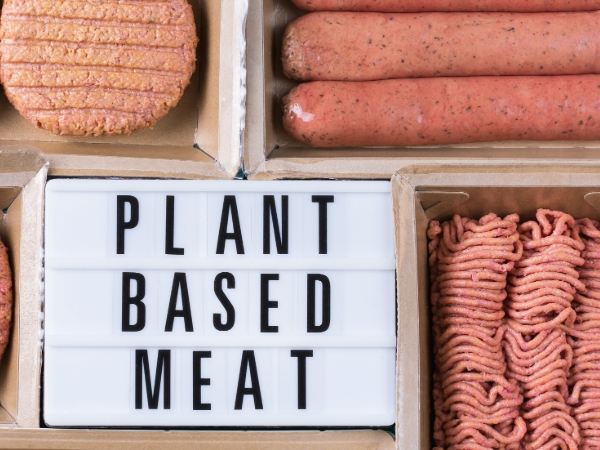
28/04/25
There has been substantial growth in recent years of consumers seeking healthier and more sustainable protein sources.
From plant-based steaks, mince, sausages and sliced meats, and the many dairy substitutes now available, to lab-grown seafood and precision-fermented cheeses, the rise of alternative proteins is reshaping dietary habits and market dynamics. The result has been a transformative shift in the global food industry, with more options to traditional animal-based proteins available than ever before.
With the rise in these products comes the need for flexible packaging that is suited to the unique requirements of plant-based and alternative proteins These are made with new and unique compositions but nonetheless demand levels of performance comparable to and exceeding the packaging of animal-based proteins, in order to ensure product integrity and preserve taste and flavour.
At the same time, consumers continue to demand packaging that provides convenience, demonstrates the provenance of the product, and is ultimately sustainable.
Opportunities and challenges
The global market size for alternative protein ingredients was estimated at $22.95 billion in 2024* and is expected to grow at a CAGR of 14.1% from 2025 to 2030 and reach a value of more than $50 billion by the start of the next decade.
This growth is being driven by several factors, including:
- Increasing consumer awareness of the health risks associated with excessive consumption of red and processed meats, such as heart disease and certain cancers;
- The environmental impact of livestock farming, including greenhouse gas emissions and deforestation; and
- Innovations in food technology, which have improved the taste, texture, and nutritional profiles of plant-based and cultured proteins, so making them more appealing to a broader audience.
For flexible packaging, the following are key considerations:
- Recyclable and circular solutions lend themselves to plant-based and alternative proteins, as the consumers of these products are actively making sustainable purchasing choices and expect the same of the brands and products they are buying.
- Many plant-based proteins are prone to oxidation, which leads to spoilage and off-flavours, making oxygen transmission rate (OTR) essential to packaging materials used for alternative proteins – moisture ingress and light barriers are also important in efforts to preserve freshness and extend shelf life;
- Plant-based dairy products and lab-grown meats often require refrigeration or freezing during their production, storage, and distribution, so packaging must be capable of withstanding low temperatures without its structural integrity being compromised;
- Performance must marry functionality, such as having high barrier lidding films that keep alternative proteins fit for human consumption at the same time as providing easy peeling and effective resealing; and
- High-quality printing is essential to maximise visibility and ensure clean and clear communication of the brand ethos and relevant product-related information that will influence consumer purchasing decisions and build brand loyalty.
Plant-based potential
As evidenced, the exploding market for plant-based and alternative proteins presents both challenges and opportunities for packaging. That is why we are delighted to support those manufacturing these products with packaging that rises to and surpasses their needs.
Take our proprietary KoroRCY laminating film, which enables the successful creation of several packaging options suitable for the new generation of protein sources. Whether that’s flow packs for dairy-free cheese, lidding films for plant-based cold cuts and vegan bacon, skin packs and thermoformed packs for lab-grown steaks and meat-free sausages, or even stand-up pouches for vegan-approved haggis. Each can be packed in mono-material packaging that is designed to be recycled but with absolutely no compromise in performance or product quality, right through the supply chain. Using a high-end 10-colour flexographic printing process, packs are guaranteed to stand out in this the increasingly competitive market for alternative proteins.
The market isn’t standing still though and there several trends are shaping the future of packaging:
- With increasing environmental awareness, there is growing demand for packaging made from materials that break down naturally, return to the ecosystem, and reduce the amount of waste going to landfill;
- Smart and active packaging technologies are enhancing consumer engagement and ensuring product quality throughout the supply chain; and
- Consumers are favouring packaging that reflects the clean, natural qualities of the products inside, leading to more minimalist designs that convey authenticity and transparent windows that allow the product to be seen.
As a leading global manufacturer of sustainable flexible packaging solutions, we are constantly working and innovating to develop our portfolio and solutions in line with the market trends, such as the growth in plant-based and alternative proteins.
These represent a significant shift in global food systems, driven by consumer demand for healthier, more sustainable options. We understand how important flexible packaging is to this transformation and ensuring that these innovative products reach consumers in optimal condition while aligning with their values and expectations.
Find out more about our range of solutions suitable for all protein types here
* Grand View Research - Alternative Protein Ingredients Market | Industry Report, 2030



